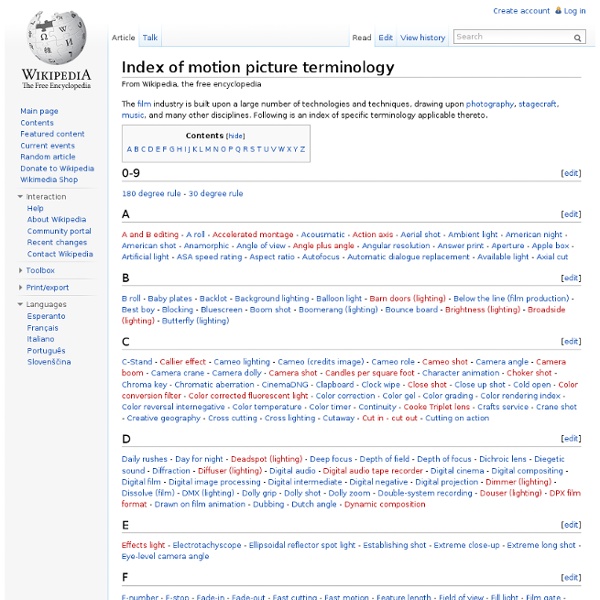



Final Cut Pro Help Provides comprehensive instructions for setting up a Final Cut Pro editing system and using Final Cut Pro to ingest media, edit video, and output completed projects. Last updated: 2010-03 Provides a fast‑paced introduction to the main features and tasks in Final Cut Pro, encouraging hands‑on exploration for new users. This document is a PDF version of the printed Exploring Final Cut Pro manual. Download the sample video files
INTERNET ENCYCLOPEDIA OF CINEMATOGRAPHERS - HOME Screenplay Basics - Scripped - StumbleUpon A Scripped Compendium by Johnathan Carr Traditional storytelling recounts past events, whereas screenwriting is locked in the present - thus you may not deviate from PRESENT TENSE. You may also be tempted to describe every inch of the world you're creating - don't! Take comfort in the idea that a screenplay is not meant to have any literary value. As you're writing, be mindful to preserve only the most important details: information that will advance the story. At the beginning of a feature film script, often but not always, the first line will be: FADE IN. While you can write a longer ACTION paragraph, think about keeping it under five lines at a time. In the ACTION line, be sure to capitalize SOUND EFFECTS, CAMERA DIRECTION and the first appearance of a speaking CHARACTER. Use a PARENTHETICAL to note an action the speaker is performing while speaking or if you want to indicate whom the speaker is addressing such as addressing a new character in mid-DIALOGUE. Think subtext.
Sound Types FindSounds Search the Web for Sounds What types of sounds can be found on the Web using FindSounds? Below is a partial list. Click on any link below to perform a search, or enter one or more words in the search box above and then click on the Search button. Animal Sounds alligator, baboon, bat, bear, bobcat, buffalo, bullfrog, camel, cat, cheetah, chimpanzee, chinchilla, chipmunk, cougar, cow, coyote, crocodile, deer, dinosaur, dog, dolphin, donkey, elephant, elk, ferret, fox, frog, gibbon, goat, gorilla, grizzly bear, guinea pig, hippo, horse, hyena, jaguar, kitten, lamb, lemur, leopard, lion, llama, marmot, monkey, moose, mouse, orca, panda, panther, pig, polar bear, prairie dog, puppy, rabbit, raccoon, rat, rattlesnake, rhinoceros, rodent, sea lion, seal, sheep, snake, squirrel, sugar glider, tiger, toad, whale, wolf, zebra Insect Sounds bee, cicada, cricket, insects, katydid, mosquito, wasp
Film Production Apps filmmaking.net | resources and community for independent filmmakers (movies filmmaking independent production filmmaker film moviemaking rec.arts.movies.production FAQ alt.movies.independent Internet Filmmaker's FAQ best film schools, film books) Observations on film art The Adventures of Prince Achmed. Kristin (with some help from David) here: David and I have been offering this greatest-of-90-years-ago series almost as long as this blog has existed. I approached 1926 with the assumption that it would present a crowded field of masterpieces; surely it would be difficult to choose ten best films. Still, the Soviet directors were going full-tilt by this time and contribute three of the ten films on this year’s list. The Russians are coming Vsevolod Pudovkin’s Mother was a full-fledged contribution to the new Montage movement in the Soviet Union. Along with Potemkin, Mother was one of the key founding films of the Montage movement. As the Mother sits beside her husband’s dead body, her son, a participant in the 1905 failed revolution, comes in. The series of five shots goes by in a few seconds, and we are challenged to grasp that the guns are a real memory, while the shots of the man’s chest and her son’s anguished face are visions of what might happen.
SOPA Emergency IP list: | CodeBangers So if these bastards in DC decide to ruin the internet, here’s how to access your favorite sites in the event of a DNS takedown tumblr.com 174.121.194.34 wikipedia.org 208.80.152.201 # News bbc.co.uk 212.58.241.131 aljazeera.com 198.78.201.252 # Social media reddit.com 72.247.244.88 imgur.com 173.231.140.219 google.com 74.125.157.99 youtube.com 74.125.65.91 yahoo.com 98.137.149.56 hotmail.com 65.55.72.135 bing.com 65.55.175.254 digg.com 64.191.203.30 theonion.com 97.107.137.164 hush.com 65.39.178.43 gamespot.com 216.239.113.172 ign.com 69.10.25.46 cracked.com 98.124.248.77 sidereel.com 144.198.29.112 github.com 207.97.227.239 # Torrent sites thepiratebay.org 194.71.107.15 mininova.com 80.94.76.5 btjunkie.com 93.158.65.211 demonoid.com 62.149.24.66 demonoid.me 62.149.24.67 # Social networking facebook.com 69.171.224.11 twitter.com 199.59.149.230 tumblr.com 174.121.194.34 livejournal.com 209.200.154.225 dreamwidth.org 69.174.244.50
Action Cam and Camcorder Accessories | BH inDepth Anyone with camcorder in hand, or action cam on head, has the chance to capture some pretty remarkable footage, maybe even something that could become a viral Web sensation. But there are lots of accessories available that make capturing great action footage even easier. If you’re an avid action-cam user, or know someone who is, these accessories are worth taking a look at. Some of them, such as the mounting accessories made by Flymount, can even turn a conventional camcorder into an action cam. If you don’t have an action cam just yet but would like one, you might want to invest in one that comes with lots of accessories right out of the box. The Swann Freestyle HD is a good example. The Aiptek Bike Mount uses a standard ¼-inch tripod mount to attach to any video camera or digital camera—anything that has a tripod mount can be accommodated. Delkin Devices makes the neat WingmanHD Waterproof 3.0 Ounce Action Camera, as well as some neat mounting devices for use with iPads.
FilmSound.org: dedicated to the Art of Film Sound Design & Film Sound Theory | The Permanent Seminar on Histories of Film Theories |